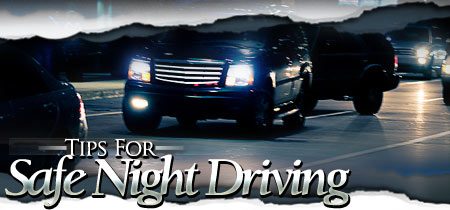
What You Need to Know About Night Driving
There are more drivers on the roads than ever before many of whom are traveling all hours of the day, all across the country, and in good and bad weather conditions.
If
you plan on driving after the sun goes down, it's important to remember that driving
at night presents different challenges than driving during the day. Traffic death
rates are three times greater at night, yet many of us are unaware of the hazards
that night driving poses or effective ways to handle them. At
night, vision is severely limited. Drivers lose the advantage of color and contrast
that is available during the day and depth perception and peripheral vision are
also diminished. To
improve your night vision and driving ability after sunset, the Motor Vehicle
Lighting Council (MVLC) offer drivers these tips:
1.
Use
your lights courteously - Turn your headlights on one hour before sunset to
make it easier for other drivers to see you in early twilight. Keep your headlights
on at least one hour after sunrise. Refrain from flashing your high beams at a
vehicle with its high beams on, this will only increase the chance that drivers
will not be able to see. In fog, use low beam headlights; high beams
reduce your own ability to see and may temporarily blind other drivers. If your
vehicle is equipped with fog lamps, use them with your low beams only when there
is fog or inclement weather.
2.
Make it easy for others to see you - Be sure all exterior vehicle lights work
properly. In case of a vehicle breakdown, pull completely off the road beyond
the end of the guardrail, if possible, and turn on emergency flashers.
3.
Avoid glare - Instead of looking at oncoming headlights, look toward the right
side of the road and watch the white line marking the outside edge of the traffic
lane. When headlights from vehicles following you reflect in your rearview mirror,
use the "day-night" feature on the mirror or adjust your mirror to cut
out as much of the light as possible.
4.
Adjust your vehicle's interior lighting - If streetlights cause a lot of glare,
dim your dashboard lights and use your sun visor. Avoid using any other light
inside your vehicle.
5.
Keep all windows and headlights clean - Dirty windows can increase glare,
making it more difficult to see, while dirty headlights can reduce efficiency
by as much as 90 percent. Be sure to clean the inside and outside of your windshield
as well as your headlights.
6.
Keep your eyes moving - Look for flashes of light at hilltops, curves and
intersections that may indicate the headlights of other vehicles.
7.
Increase your following distance - Increasing your distance by four to five
seconds can make it easier to spot potential problems on the roadway
and give you more time to respond. In addition, proper lighting will enable you
to react quicker and stop at a safe distance from the vehicle in front of you.
8.
Regulate speed - Driving too fast is more dangerous after dark than during
the day because of decreased visibility. Traveling at high speeds doesn't allow
you enough time or distance to stop when you see something dangerous on the road
ahead.
9.
Prevent fatigue - Night driving can be tiring, so ensure good ventilation
inside the vehicle and take frequent refreshment breaks to give your eyes a chance
to recover. Take a short nap or a brisk walk, or have some caffeine to help you
stay alert.
10.
Use vehicle mirrors to your advantage - Exterior mirrors that are properly
aligned not only reduce blind spots, they also reduce glare from vehicles behind
you. The outside rearview mirrors should be adjusted so that the bodywork of the
vehicle is just outside of the driver's view. In addition, the rearview mirror
can be flipped to its "day-night" setting, which changes the angle of
the reflective surface and appears to dim the mirror.
In
addition, there are also some general practices you can follow to help ensure safe
night driving:
1.
Align your headlights correctly - Properly aligned headlights will help you
see the road better and will help other drivers avoid glare. If you live in a
state that requires regular safety inspections, ask the service technician to
check and correct the aim of your headlights. If your state doesn't require such
an inspection, take your vehicle to a dealer or repair shop at least once a year
for a headlight checkup.
2.
Have your vision checked regularly - The American Optometric Association recommends
that everyone under the age of 40 have a thorough eye exam at least every three
years; drivers 41-60 every two years; and drivers over 60 every year. Age can
make eyes more sensitive to glare. In addition, certain medical conditions, such
as encroaching cataracts, will increase eye sensitivity.
3.
Look into anti-reflective eyeglass coating - Many eye care professionals strongly
recommend eyeglasses that have an anti-reflective (AR) coating. This ultra-thin
film reduces internal reflections in the lenses. AR-coated glasses actually transmit
more light than regular lenses, which improves vision at night and helps distinguish
fine details during the day.
Source: Motor Vehicle Lighting Council |